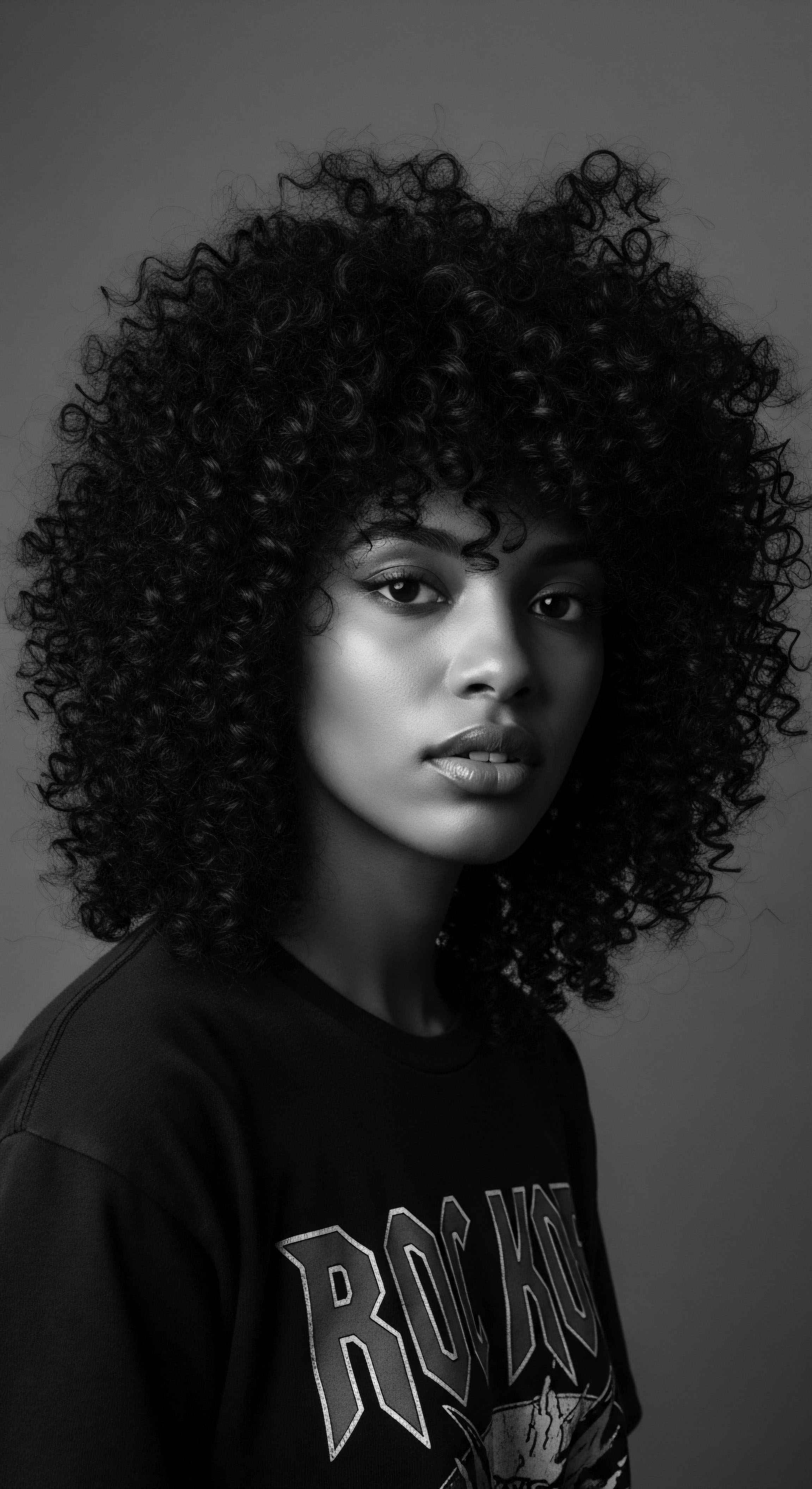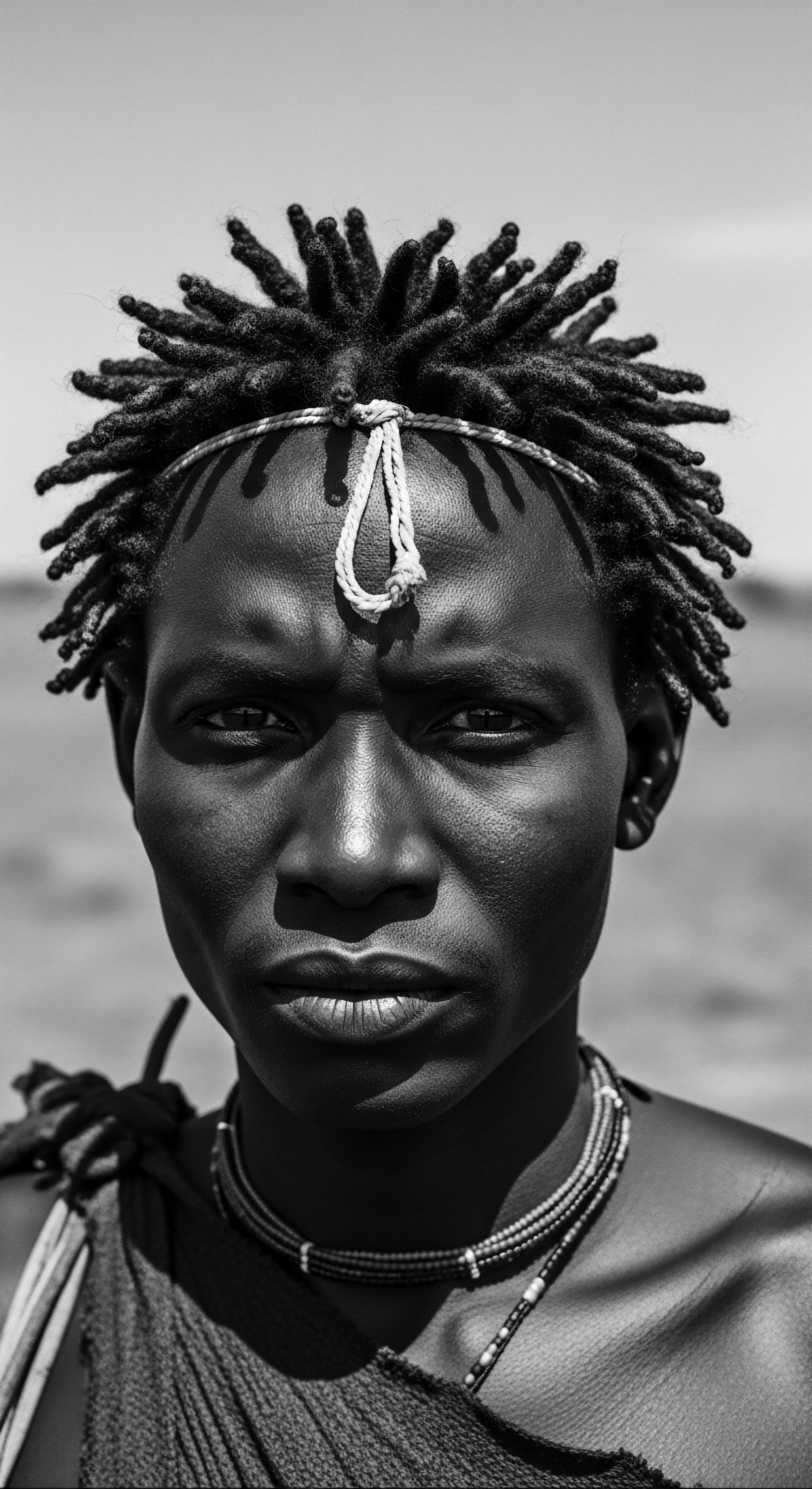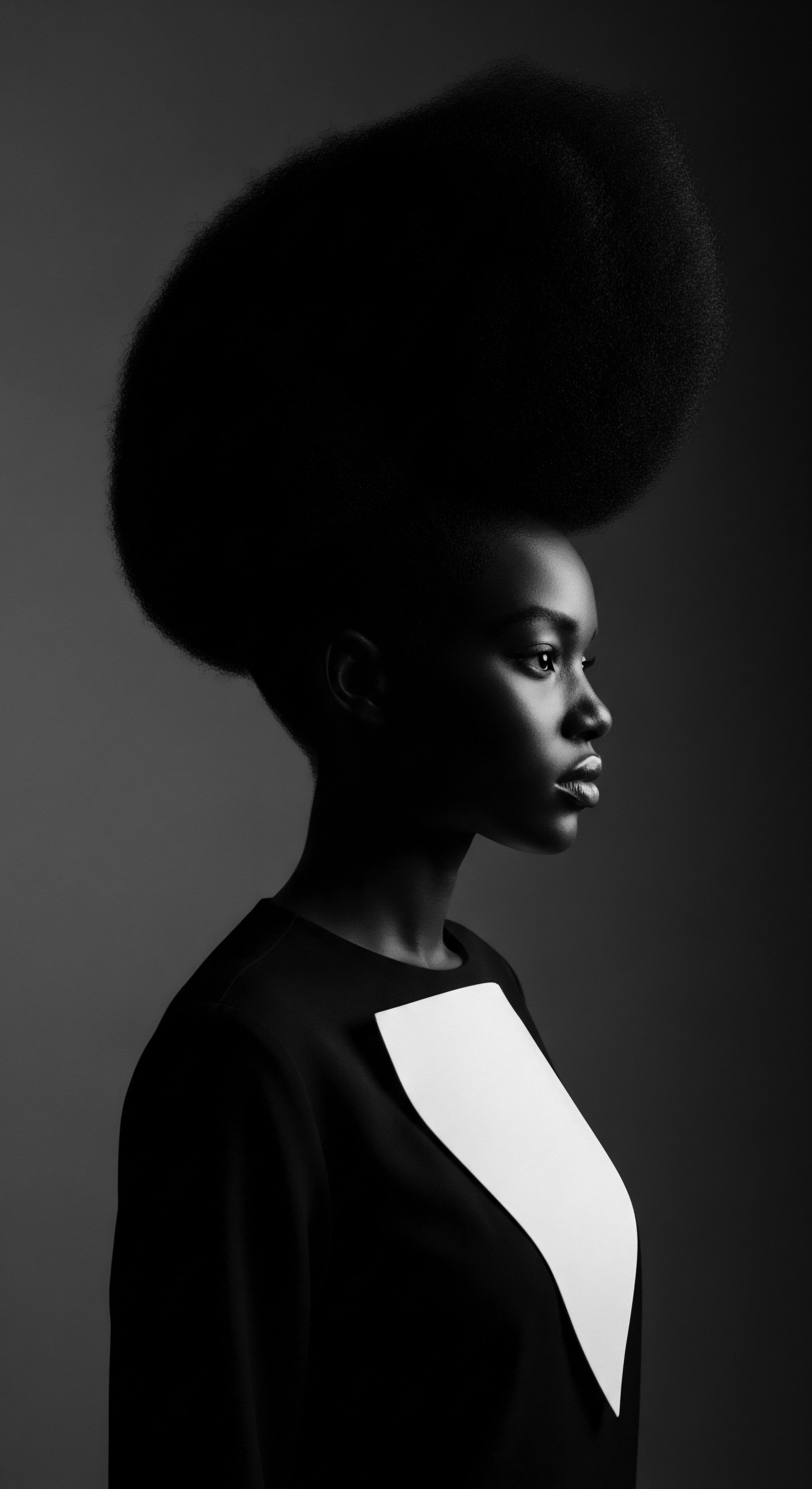
Roots
Consider the whisper of the winds across ancient savannahs, carrying the scent of rich earth and the quiet strength of generations. Within these echoes, for Black communities across the globe, hair is a chronicle, a living parchment, deeply imprinted with heritage. It is not merely a biological structure, but a sacred connection to ancestry, a testament to resilience, and a vibrant canvas for identity.
Traditional hair oils, born from the generosity of the land and the ingenuity of communal wisdom, represent a profound chapter in this story. They are not simply conditioners or emollients; they are the tangible threads that bind Black peoples to their ancestral practices, to moments of profound care, and to the enduring spirit of their lineage.

Unveiling the Textured Hair Structure
Understanding the historical significance of traditional hair oils first requires a contemplation of the very structure of textured hair itself. Afro-textured hair, in its myriad forms, possesses a unique helical shape, ranging from broad, loose spirals to tight, kinky coils. This distinct geometry, often characterized by its elliptical cross-section and numerous bends, influences how natural oils produced by the scalp travel down the hair shaft. Gravity, of course, aids this journey on straight hair, but for coily strands, the path is circuitous, making it more challenging for sebum to reach the ends.
This inherent characteristic often results in drier hair, a biological reality that ancestral communities intuitively addressed through external application of nourishing substances. The hair cuticle, the outermost protective layer, tends to be more open on highly textured hair, allowing moisture to escape more readily. This fundamental biological reality underscored the daily practices of sealing and moisturizing, which became central to hair care.
Traditional hair oils stand as a testament to ancestral ingenuity, born from a profound understanding of textured hair’s unique needs.

Ancestral Lexicon and Hair’s Deep Past
The nomenclature surrounding textured hair, even before formalized modern classification systems, was often embedded in cultural contexts and spiritual reverence. Hair was understood as a conduit for spiritual connection, the highest point of the body, a receiver of divine messages. In pre-colonial African societies, hairstyles alone conveyed information about a person’s age, marital status, social standing, tribal affiliation, and even religious beliefs. For example, among the Yoruba people, hair was considered the most elevated part of the body, and intricate braided styles served as a means of communicating with the divine.
The practices surrounding hair, including oiling, were not casual; they were ritualized acts, often performed communally, strengthening familial and social bonds. The very terms used to describe hair and its care were deeply woven into the fabric of daily life and spiritual understanding.
| Traditional Understanding of Hair Hair as a spiritual antenna connecting to ancestors. |
| Modern Scientific Link for Textured Hair The hair shaft's unique structure and porosity, requiring specific external support for health. |
| Traditional Understanding of Hair Oils providing a protective shield against the elements. |
| Modern Scientific Link for Textured Hair Lipids and fatty acids in oils reinforcing the cuticle, reducing moisture loss, and offering UV protection. |
| Traditional Understanding of Hair Communal hair care as a bonding experience. |
| Modern Scientific Link for Textured Hair The psychological and social benefits of shared care rituals, fostering community and self-esteem. |
| Traditional Understanding of Hair Certain oils bringing strength and vitality. |
| Modern Scientific Link for Textured Hair Specific vitamins and antioxidants within oils supporting scalp health and minimizing breakage. |
| Traditional Understanding of Hair The enduring wisdom of traditional hair practices finds validation in contemporary scientific understanding. |

Oils as Elemental Protectors
From the fertile lands of West Africa to the desert expanses of Southern Africa, indigenous trees and plants offered up their bounties in the form of oils and butters. These natural offerings served as primary defenses against harsh climates, offering essential moisture and protection. Shea butter, sourced from the shea tree in West Africa, has been a cornerstone of skincare and hair care for centuries, valued for its ability to protect from sun, wind, and dust.
Similarly, palm oil, native to West and Southwest Africa, has been used for thousands of years, not just for culinary purposes, but also in skin and hair care, valued for its ability to hydrate and nourish. These substances were applied not just for aesthetic appeal, but for their fundamental role in preserving the integrity of the hair strand, ensuring its flexibility and minimizing breakage in environments where hair could quickly become brittle.

Ritual
The application of traditional hair oils transcended simple grooming; it was, and remains, a deeply ingrained ritual, a tender thread connecting daily practice to ancestral wisdom. These rituals were moments of self-care, of community, and of the preservation of heritage, where each stroke of oil carried generations of knowledge. The act of oiling was often a communal activity, passed down through the hands of mothers, grandmothers, and aunties, teaching not only technique but also the deeper reverence for one’s crown.

Oils in Protective Hair Arts
Protective styling, a hallmark of textured hair care, relies heavily on the thoughtful application of traditional oils. Styles like braids, twists, and locs, which have roots stretching back thousands of years in African cultures, were not merely aesthetic choices; they were strategic methods to shield the hair from environmental damage, reduce manipulation, and retain length. Oils were fundamental to preparing the hair for these styles, providing lubrication to reduce friction during braiding, sealing in moisture, and ensuring scalp health throughout the duration of the protective style.
- Shea Butter ❉ A staple in West Africa for centuries, used to moisturize and protect hair, especially when preparing for intricate styles like braids and locs. It aids in nourishing the scalp and strands.
- Palm Oil ❉ Beyond its culinary uses, black palm kernel oil has been used in skin and hair care, valued for its ability to thicken hair strands and reduce breakage, particularly in West African traditions.
- Manketti Oil ❉ Sourced from Southern Africa, communities have historically used this oil as a lotion to detangle and strengthen hair, forming a protective film without leaving an oily residue.
Hair oiling rituals transformed practical care into acts of cultural preservation and communal connection.

What Historical Examples Guide Our Understanding of Hair Oils’ Role?
One powerful historical example of oil’s pervasive significance in hair care comes from the Himba people of Namibia. For generations, Himba women have adorned their hair and skin with a mixture known as Otjize, a paste created from butterfat and ochre, often combined with aromatic resins or herbs. This vibrant, reddish paste serves multiple functions ❉ it protects the skin and hair from the harsh desert sun, acts as a cleanser, and holds deep cultural and aesthetic significance, symbolizing beauty, wealth, and connection to the earth.
The butterfat component provides essential moisture and a protective barrier, demonstrating an ancestral understanding of environmental protection for textured hair through natural oils. This practice is not merely about appearance; it embodies a holistic approach to wellbeing, integrating ancestral knowledge, environmental adaptation, and cultural identity.
This tradition illustrates how hair oils were not just functional; they were intertwined with the very fabric of identity and community. The lengthy process of preparing and applying otjize, often a communal activity, reinforces social bonds and transmits cultural knowledge across generations. It reveals how traditional hair care, deeply rooted in the land and its resources, becomes a daily reaffirmation of cultural belonging and a powerful visual statement of heritage.

Ceremony and Daily Care
Beyond specific styling, traditional oils were integral to the daily maintenance and ceremonial presentation of hair. The act of oiling often accompanied combing, detangling, and sectioning, transforming these tasks into mindful, almost meditative, processes. For young girls, learning these rituals from elder women was a rite of passage, teaching patience, self-care, and the value of their unique hair texture.
These rituals also extended to ceremonial contexts, where elaborately oiled and styled hair marked significant life events, from rites of passage to marriage ceremonies. The luster and health imparted by these oils were seen as direct reflections of a person’s vitality and status within the community.

Relay
The historical journey of traditional hair oils within Black communities does not stop in antiquity; it relays forward, a continuous current informing contemporary practices and empowering modern hair journeys. The ancestral wisdom embedded in these oils provides a crucial foundation for understanding holistic textured hair care, extending beyond mere cosmetic application to encompass mental wellness and cultural affirmation.

Holistic Hair Care Through Generations
The ancestral approach to hair care inherently understood hair as an extension of overall wellbeing. It was not isolated but connected to diet, spiritual health, and communal living. Traditional hair oils, therefore, were often infused with herbs and botanicals, becoming potent elixirs that addressed not just superficial hair needs but also scalp health, which is the very ground from which healthy hair grows.
This deep understanding of scalp health is evident in practices that utilized ingredients like African black soap for cleansing and nourishing the scalp without stripping its natural oils. The continuous application of oils and butters maintained the scalp’s delicate balance, promoting an optimal environment for hair to thrive.
Modern science often validates these long-standing practices. Coconut oil, for instance, with its low molecular weight and high content of lauric acid, can deeply penetrate the hair shaft, reducing protein loss during washing and protecting against hygral fatigue, a common concern for textured hair prone to expansion and contraction with water. This scientific insight provides a clear explanation for why coconut oil has been a staple in Caribbean and other diasporic hair traditions.
- Coconut Oil ❉ Prized for its ability to penetrate the hair shaft, strengthening strands and reducing protein loss, especially beneficial during wash processes.
- Jojoba Oil ❉ While indigenous to North America, its properties that mimic natural sebum resonated strongly with Black beauty traditions, offering effective moisture and scalp hydration, particularly gaining prominence in the natural hair movement of the 1970s as an act of resistance.
- Castor Oil ❉ Known for its thick consistency, historically used to moisturize, protect, and strengthen hair and scalp in various African and diasporic communities.

Do Traditional Hair Oils Still Hold Relevance in Contemporary Care?
Absolutely. The enduring significance of traditional hair oils is perhaps most visible in the ongoing natural hair movement. This contemporary reclamation of natural texture, spurred by a rejection of Eurocentric beauty standards, sees Black communities returning to the very practices and ingredients that sustained their ancestors. The wisdom passed down through generations—the knowledge of which oils to use, how to blend them, and when to apply them—has experienced a resurgence, often shared through online communities and personal journeys.
A critical aspect of this continuation lies in problem-solving common textured hair concerns. Dryness and breakage, often exacerbated by environmental factors or historical practices of chemical straightening, find remedies in these time-honored oils. They act as sealants, preventing moisture evaporation, and as conditioners, softening the hair strands to reduce tangles and mechanical damage.
The ritual of “greasing” the scalp, a tradition passed down from African ancestors, continues today, emphasizing the importance of moisturizing the scalp and roots for overall hair health. This practice, though sometimes critiqued in modern contexts, holds historical weight as a foundational element of care.
The evolution of oil usage can be seen across the diaspora. In colder European climates, for example, African immigrants often adjust their hair care to incorporate more protective oils against harsh weather, prioritizing moisture retention. This adaptability showcases the living nature of these traditions, always responding to new environments while holding onto core principles of care.
| Traditional Oil Shea Butter |
| Ancestral Application and Cultural Context Used for centuries by West African women to protect skin and hair from harsh elements, a sacred symbol of fertility and purity. |
| Traditional Oil Palm Kernel Oil |
| Ancestral Application and Cultural Context In West Africa, valued for thickening hair strands, reducing breakage, and nourishing newborns. |
| Traditional Oil Manketti Oil |
| Ancestral Application and Cultural Context Historically used by Southern African tribes (e.g. San, Kwangali) for detangling, strengthening, and protecting hair from sun. |
| Traditional Oil Coconut Oil |
| Ancestral Application and Cultural Context A staple in Caribbean and African hair care, cherished for deep moisture and strengthening hair against damage. |
| Traditional Oil These oils represent a living heritage, their historical applications informing contemporary care practices. |

Reflection
The historical significance of traditional hair oils for Black communities is more than a study of botanicals and practices; it is a profound meditation on the resilience of a people, the enduring power of ancestral wisdom, and the intimate connection between hair and identity. These oils, extracted from the very earth beneath their feet, became silent witnesses to centuries of struggle, adaptation, and unwavering self-affirmation. They represent a language spoken through touch, a legacy carried on every strand, a quiet yet potent act of resistance against erasure.
From the symbolic narratives etched into ancient hairstyles, kept vibrant with rich emollients, to the covert preservation of hair rituals during periods of profound dehumanization, oils have been constant companions. They were not just a means to lubricate a strand or soothe a scalp; they were the essence of care, a tangible link to home, and a continuous thread of dignity. As our understanding of textured hair deepens, both through scientific inquiry and through a renewed appreciation for cultural practices, we recognize that the ‘Soul of a Strand’ is truly found in this interwoven history. It is in the memory held within the oils, the hands that applied them, and the communities that kept these vital traditions alive, ensuring that the heritage of textured hair continues to shine.

References
- BLAM UK CIC. The History of Black Hair. 2022.
- Reddit. No Raw Oils and Butters vs. Traditional African Hair Care. 2021.
- African American Museum of Iowa. History of Hair.
- Refinery29. The Evolution of the Natural Hair Movement. 2021.
- Hair Care Practices from the Diaspora ❉ A Look at Africa, America, and Europe. 2025.
- Africa Imports. Traditional African Secrets for Long and Healthy Hair.
- What Every Dermatologist Must Know About the History of Black Hair. 2023.
- Kupanda. Buhle Manketti Oil.
- Unlocking Ancient African Beauty Traditions ❉ A Tribute to Black History Month with Timeless Indigenous Ingredients for Radiant Skin and Hair. 2024.
- Know Your Hairitage. African Culture.
- Never the Less Inc. History of Black Hair Care.
- LASPA Naturals. The History of Black Skincare.
- Aromaaz International. Manketti Oil (Mongongo).
- Ancient African Hair Growth Secrets that Easily Grow Healthiest Longest Natural Hair. 2023.
- Livara Natural Organics. Black History Month ❉ The Rich History of Our African Hair. 2023.
- Assendelft. Pre-Colonial African Hairstyles ❉ A Journey Through Time and Culture.
- The Resilient Tresses ❉ West African Black Hair History from the 1400s to Today. 2024.
- Sellox Blog. Ancient African Hair Growth Secrets for Healthy Hair. 2021.
- New Directions Aromatics. Red Palm Oil & Palm Kernel Oil – For Hair Care & Skin Care. 2017.
- ELLE. A Brief History of Black Hair Rituals. 2020.
- Amazon.com. Generic African Traditional Handmade Layden Oil for Scalp & Hair Roots Strengthening.
- BeautyMatter. The Untold Story of Jojoba Oil in Black Beauty. 2025.
- C+R Research. The Connection Between Hair and Identity in Black Culture. 2024.
- Afrinatural. Manketti / Mongongo Seed Oil.
- sheabutter.net. Discovering the Origins of Shea Butter – A Journey to the Heart of Africa. 2024.
- AfroHairCandy. Coconut Oil and AfroHairCandy. 2023.
- PsychoHairapy. Our Hair ROOTS ❉ Incorporating Our Black Family Hair Traditions and Routines as a Coping Technique to Increase Positive Mental Health. 2024.
- Nature In Bottle. Mongongo Manketti Oil Organic.
- KhalidaNaturals. Kinky Hair Growth Oil (West African Batana Oil).
- Black Women Radicals. How Naturals in and Outside the U.S. Maintain What’s On and In Their Crown During a Pandemic. 2020.
- grain.org. A long history and vast biodiversity. 2014.
- Jean Louis David. Shea ❉ African women’s golden product.
- African Beauty and Skincare ❉ A Deep Dive into History, Traditions, and Natural Ingredients. 2025.
- Hydrating Organic Manketti Oil – Transform Your Hair Care Routine & Unlock Radiant Skin.
- Substack. Ancestral Hair Rituals to Nourish Your Hair and Soul. 2025.
- Cécred. Understanding Hair Oiling ❉ History, Benefits & More. 2025.
- World Rainforest Movement. Africa ❉ Where Palm Oil is Still a Source of Life. 2015.
- East African Secrets. Rapid Hair Growth Oil.
- Omez Beauty Products. The Cultural Significance of Natural Hair. 2024.
- Refinery29. Braids, Wigs, & Wash Day Routines ❉ 4 Black Women on the Meaning Behind Their Hair Rituals. 2022.
- Whole Elise. Ayurvedic Hair Oil. 2022.
- sheabutter.net. A History of Shea Butter.
- WWF. 8 things to know about palm oil.
- Paulski Art. The Rich History of Shea Butter and Its Origins. 2024.
- Sweet Cecily’s. 7 Natural Benefits of Using Coconut Oil for Your Hair and Skin. 2022.
- AOCS. Coconut Oil Boom.
- Newsweek. Everything You Need to Know About the Ancient Art of Hair Oiling. 2022.
